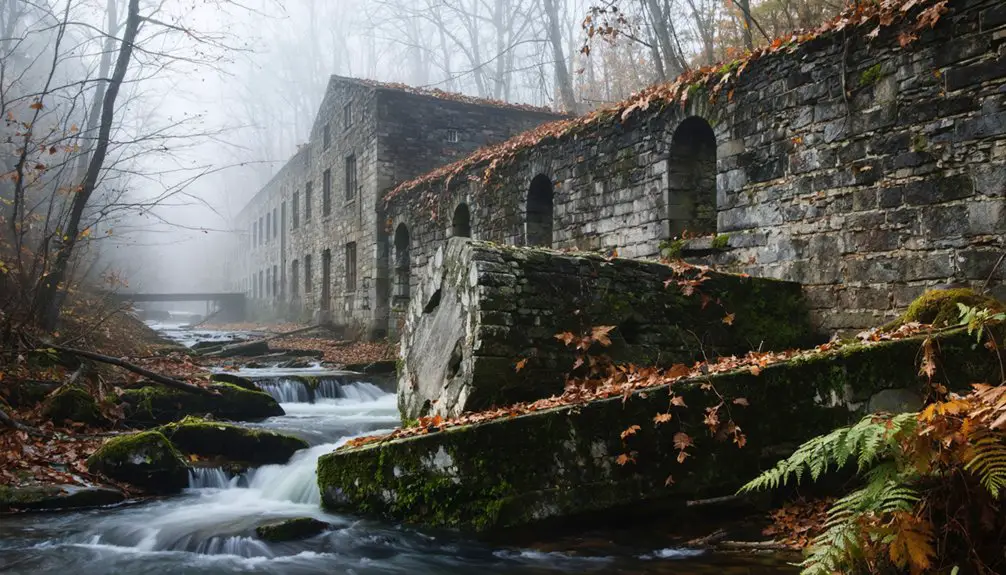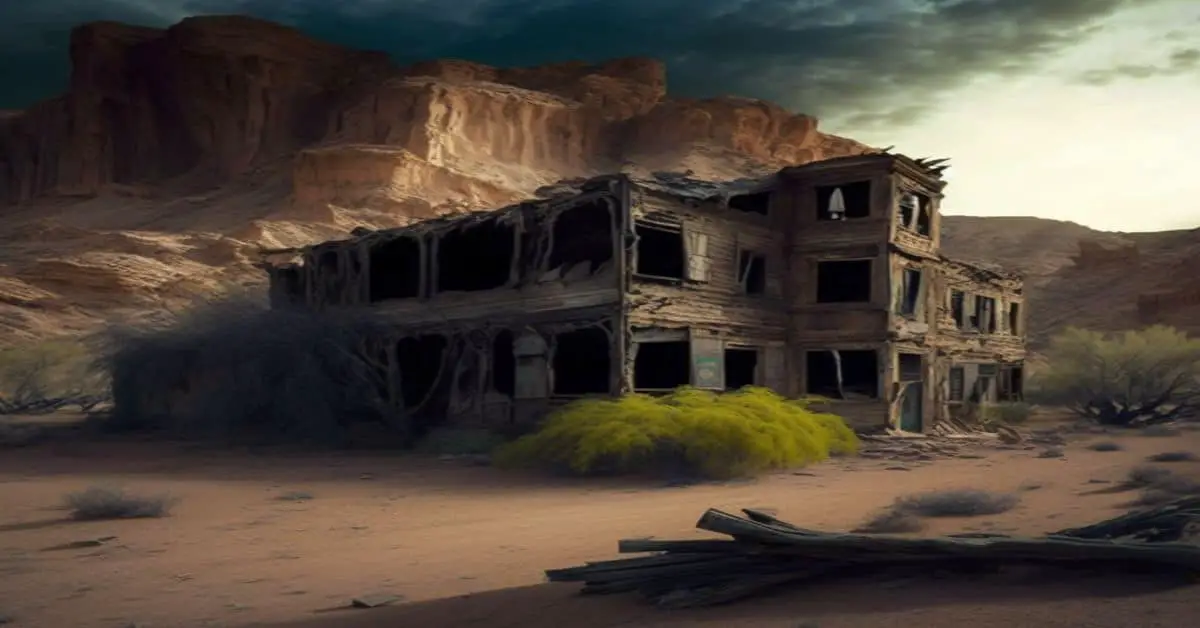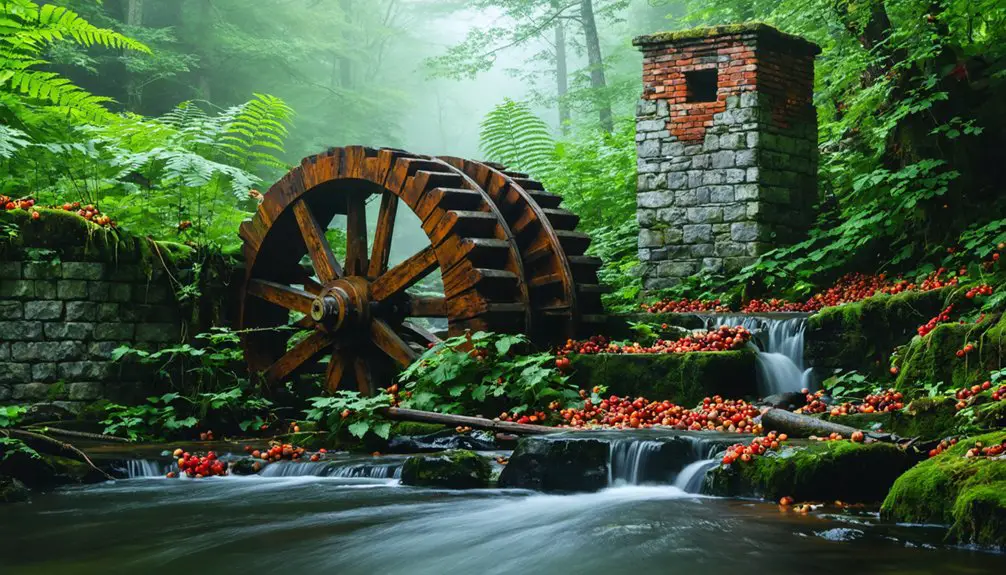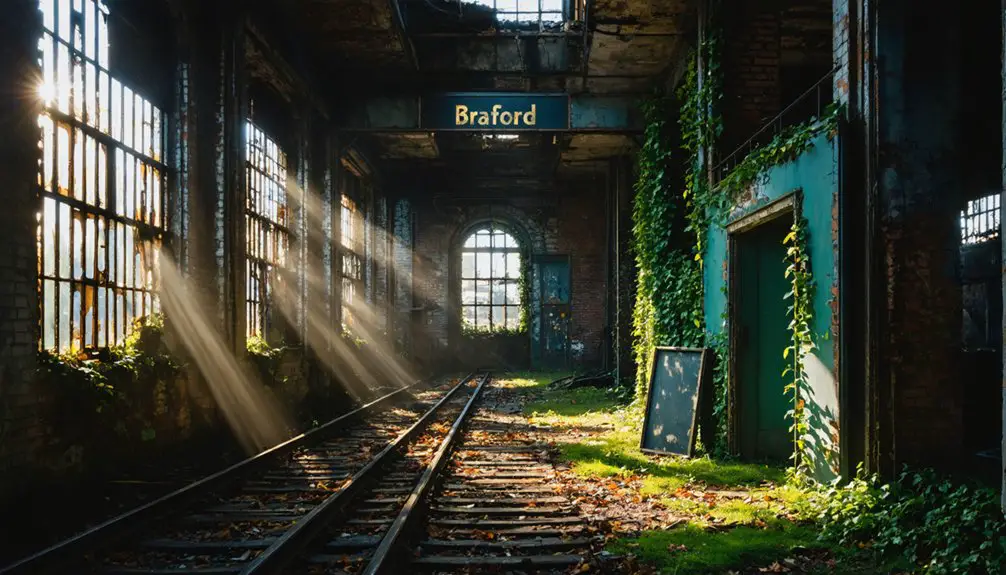You’ll discover Hope Valley’s transformation from a bustling 19th-century mill town to a haunting reminder of New England’s industrial past. Originally established around Carpenter’s Mills in 1770, the area flourished with the Hope Webbing Company Mill, producing 1.5 million yards of fabric annually by 1897. The mill’s closure in 1994 marked the end of an era, leaving behind preserved structures that now attract urban explorers and paranormal enthusiasts. The hidden remains of the Enchanted Forest Park add another layer to this fascinating ghost town’s mysteries.
Key Takeaways
- Hope Valley transformed from a bustling mill town to a quiet residential area after industrial decline, particularly following the Hope Webbing Company’s closure.
- The abandoned Hope Valley mill complex, which once produced 1.5 million yards of fabric annually, stands as a testament to lost industry.
- Former industrial sites and empty mill buildings attract ghost hunters and urban explorers interested in the area’s paranormal reputation.
- The community experienced significant population loss as families departed following mill closures in the early 1900s.
- The abandoned Enchanted Forest Park, hidden in Hope Valley’s woodland, represents another layer of the area’s ghost town characteristics.
Historical Background and Early Settlement
While the Wood River shaped Hope Valley’s early development, it was Hezekiah Carpenter who first established a permanent European-American settlement there around 1770.
You’ll find that early settlement patterns centered around Carpenter’s Mills, where he built a dam to power local milling operations along the river. Local industrial activity flourished when the Hope Furnace began producing household goods and military supplies in 1766.
The area’s early governance evolved from its origins as part of Westerly, Rhode Island’s fifth colonial town.
Through various subdivisions, including the separation of Charlestown and Richmond, Hope Valley emerged within Hopkinton’s boundaries. The early inhabitants of the region were the Little Narragansett tribe before European settlement began.
The 1709 Shannock purchase brought 27 settler families to the region, including names you’ll still recognize today: the Barbers, Browns, Clarkes, Hoxsies, Kenyons, Utters, Crandalls, Teffts, and Perrys.
These families shaped the village’s close-knit social structure and conservative political outlook.
The Rise and Fall of Mill Industry
You’ll find Hope Valley’s industrial roots in the early 1800s, when Rhode Island’s mill expansion transformed the region from a quiet farming community into a bustling manufacturing center.
The area reached its manufacturing peak with the Hope Webbing Company Mill, established in 1889, which grew to become one of America’s largest narrow fabric producers with extensive additions completed by 1914. By 1897, the facility was manufacturing an impressive 1.5 million yards of narrow fabrics annually.
Before the industrial boom, Hope Valley was known as Carpenter’s Mills for over three decades, reflecting its early manufacturing identity.
The mill’s eventual closure in 1994 marked the end of an era, as global competition and changing markets forced the once-thriving industrial complex to relocate operations to Cumberland, leaving behind the shell of what would become today’s ghost town.
Early Industrial Foundations
During the mid-18th century, Hope Valley’s industrial identity took shape along the North Pawtuxet River, where the construction of water-powered mills transformed the rural landscape into a thriving manufacturing hub.
You’ll find evidence of this industrial innovation in structures like the Old Stone Dam, built around 1765, which powered the region’s early manufacturing ventures. The dam’s design replicated English countryside dams, facilitating efficient water management for the mills.
The pinnacle of mill architecture emerged with Brown & Ives’ 1844 stone mill, setting the stage for larger developments like the Hope Webbing Company Mill in 1889.
These facilities weren’t just isolated buildings – they formed the heart of a carefully planned community. Mill owners established an integrated network of worker housing, canals, and eventually railroads, creating a self-contained industrial ecosystem where approximately 25% of Hope Village homes served as worker residences.
Peak Manufacturing Era
The late 19th century marked Hope Valley’s transformation into an industrial powerhouse, as the Hope Webbing Company’s 1889 establishment set off a remarkable period of expansion.
To avoid geographical confusion, several other Hope Valleys exist across different regions, making this Rhode Island location historically distinct.
You’d find manufacturing innovations everywhere – from the massive 100,000-square-foot preparing building to the interconnected weave sheds linked by covered walkways.
Decline and Economic Shifts
Although Hope Valley once thrived as an industrial powerhouse, its economic foundation began crumbling in the early 1900s as mill closures swept through the region.
You’ll find that this economic transformation fundamentally altered the town’s community identity, shifting it from a bustling manufacturing hub to a quiet residential area.
The decline’s impact became evident through:
- Mass workforce displacement, particularly affecting women and children who’d been the backbone of textile operations
- Significant population losses as families sought opportunities in other industrial centers
- Dissolution of mill-supported institutions including company stores, schools, and worker housing
You’re witnessing the legacy of these changes today, as former textile operations gave way to agricultural pursuits, mainly dairy farming, though even that industry eventually faded into history.
Enchanted Forest: A Lost Wonderland
Once enchanting visitors with its whimsical fairy tale atmosphere, Enchanted Forest opened its gates in Hope Valley, Rhode Island in 1971 as a magical wonderland designed specifically for families with children.
Step into a storybook dream where Rhode Island’s Enchanted Forest brought fairy tales to life for families seeking magical memories.
You’d find yourself wandering through 31 acres of wooded landscape, where enchanted nostalgia came alive through attractions like “The House That Jack Built” and a towering Humpty Dumpty perched atop his brick wall.
A natural pond with cascading waterfalls served as the park’s heart, while whimsical memories were made at the child-sized roller coaster, petting zoo, and spinning teacups. The park eventually expanded its attractions to include popular rides like the Scrambler and Ferris Wheel.
Local vocational students from Chariho High School helped build many displays, weaving community spirit into every corner of this carefully crafted paradise that intentionally preserved its natural forest setting. After decades of bringing joy to families, the beloved attraction sadly reached its final chapter when it closed in 2005.
Local Legends and Paranormal Tales
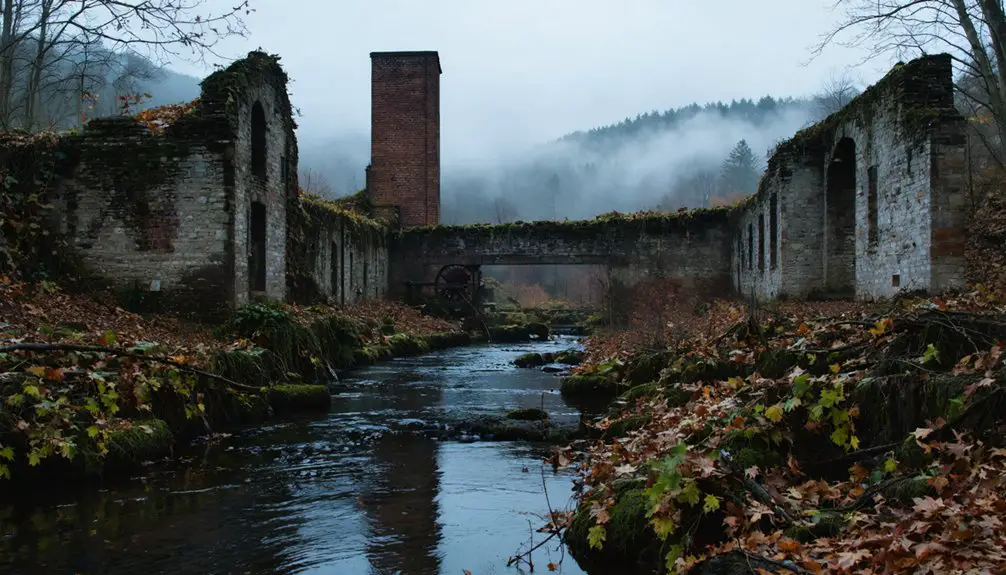
Behind Enchanted Forest‘s storybook charm lies a darker chapter in Hope Valley’s history, one filled with spectral tales and mysterious phenomena that continue to captivate locals and visitors alike.
Ghost stories center around Bathsheba Sherman, an alleged witch born in 1812, and the historic Arnold Estate, where unexplained events have sparked numerous paranormal investigations. The property now offers one-hour day tours for those brave enough to explore its haunted halls. Some visitors have reported experiencing mysterious sounds and scents, similar to manifestations documented in other haunted locations.
If you’re drawn to the supernatural, you’ll find three distinct types of spectral sightings in Hope Valley:
- Translucent apparitions drifting through abandoned farmhouses and mills
- Shadow figures accompanied by unexplained footsteps and whispers
- Playful spirits of children, reportedly linked to former amusement sites
You’ll discover these tales aren’t just local folklore – they’ve shaped Hope Valley’s identity, inspiring ghost tours, paranormal tourism, and even Hollywood films like The Conjuring.
Exploring Abandoned Sites Today
Despite the allure of Hope Valley’s abandoned sites, exploring the Enchanted Forest today requires careful consideration of both legal and safety constraints.
Urban explorers must balance their fascination with abandoned places against safety risks and legal boundaries.
You’ll find the property is strictly private, with new gates and “No Trespassing” signs installed after its 2021 sale. While urban exploration footage on YouTube and TikTok showcases the haunting beauty of decaying rides and nature’s reclamation, visiting the site yourself isn’t legally permitted.
Safety concerns are significant, with unstable structures and overgrown vegetation creating hazardous conditions throughout the former amusement park.
Though you might spot remnants of the miniature golf course, bumper cars, and other attractions through drone footage and social media documentation, it’s essential to respect private property rights and avoid unauthorized access that could result in prosecution.
Preserving Hope Valley’s Heritage
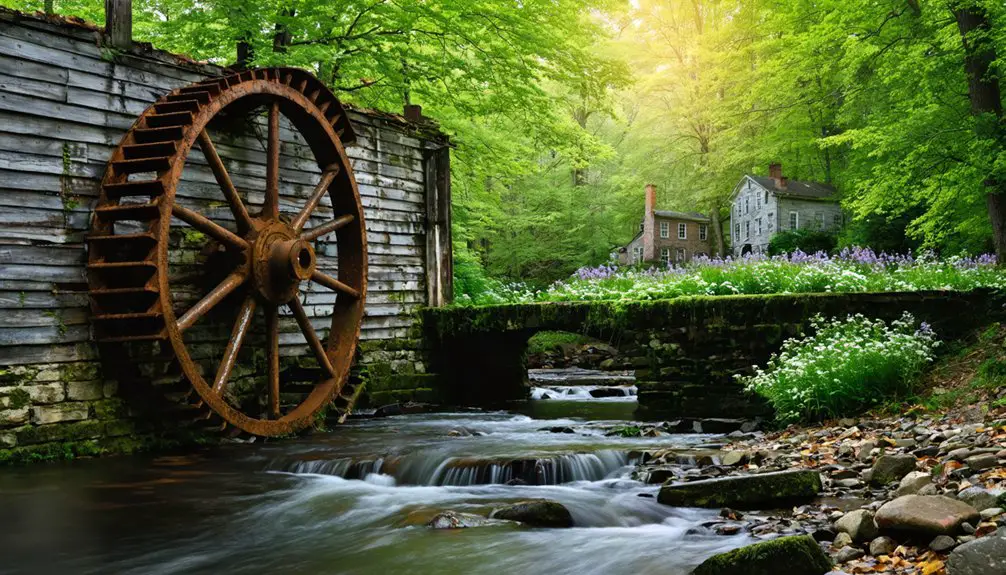
While many ghost towns fade into obscurity, Hope Valley’s rich heritage lives on through extensive preservation initiatives.
You’ll find dedicated historians and volunteers working tirelessly to protect this unique slice of Rhode Island’s past, facing preservation challenges head-on through coordinated heritage initiatives.
Here’s how you can explore Hope Valley‘s preserved history:
- Visit the local museums and heritage centers showcasing digitized archives, photographs, and artifacts from the town’s industrial heyday.
- Join guided heritage walks that bring the ghost town’s stories to life through expert interpretation and restored historical markers.
- Participate in community workshops where you’ll learn about preservation efforts and help maintain historic structures.
These preservation efforts guarantee that future generations can experience Hope Valley’s fascinating transformation from thriving mill town to atmospheric ghost town.
Impact on Rhode Island Tourism
Hope Valley’s preserved mill village structures and haunting atmosphere make it a distinctive addition to Rhode Island’s historic tourism destinations.
You’ll find that ghost-hunting enthusiasts and history buffs are drawn to the town’s paranormal reputation and architectural remnants, creating a specialized tourism niche that brings new visitors to the state.
The increased tourism activity supports local businesses through guided tours, specialty shops, and seasonal events, while maintaining the site’s authentic character through careful preservation efforts.
Historical Site Preservation
Historical sites in Rhode Island have emerged as powerful catalysts for tourism, with preservation efforts in ghost towns like Hope Valley playing a crucial role in the state’s heritage tourism sector.
You’ll find careful preservation techniques being applied to maintain the historical significance of colonial-era buildings and landmarks throughout these abandoned settlements.
When you explore Hope Valley, you’ll discover:
- Meticulously restored farmhouses and mill sites that showcase authentic colonial architecture
- Interactive exhibits and guided tours that bring the past to life through interpretive programming
- Adaptive reuse projects that have transformed historical structures into museums and cultural centers
These preservation efforts don’t just protect Rhode Island’s cultural heritage – they’re creating sustainable tourism opportunities that support local economies while keeping the state’s rich history accessible for future generations.
Paranormal Tourism Appeal
What draws thousands of visitors to Rhode Island’s ghost towns each year? You’ll find an intriguing mix of history buffs, thrill-seekers, and ghost hunting enthusiasts drawn to Hope Valley’s supernatural experiences.
The area’s haunted mansions, lighthouses, and historic buildings offer year-round paranormal tours that blend documented history with spine-tingling folklore.
You can join specialized ghost tours and pub crawls that consistently earn high ratings on social media platforms, indicating strong visitor satisfaction.
These paranormal activities help sustain local tourism during off-peak seasons, creating jobs and boosting the regional economy.
Beyond pure entertainment, you’re getting an interactive education in colonial and early American history through engaging storytelling.
The tours serve as a gateway for families and younger audiences to connect with Rhode Island’s rich historical heritage through paranormal exploration.
Local Economy Effects
The closure of Enchanted Forest Amusement Park in 2005 dealt a significant economic blow to Hope Valley’s tourism sector.
You’ll find the impact rippled through the local economy, affecting businesses that once thrived on visitor traffic. Despite attempts at economic revitalization strategies, the region’s faced ongoing challenges.
The closure’s domino effects include:
- Significant job losses in seasonal employment and park maintenance
- Decreased revenue for nearby restaurants, shops, and lodging establishments
- Reduced property values and diminished commercial investment interest
Community engagement initiatives haven’t yet offset these losses, as Rhode Island’s tourism largely gravitates toward coastal areas.
While the site’s ghost town status draws some paranormal enthusiasts, it’s not enough to replace the sustained economic activity the park once generated for Hope Valley’s local businesses and workforce.
Urban Explorer’s Guide
Before venturing into Hope Valley’s abandoned landscapes, urban explorers should familiarize themselves with both accessible and restricted areas of this historic ghost town.
You’ll need to navigate dense underbrush and swampy woodlands, so timing your visit during winter or early spring offers safer conditions. While Scott Tower welcomes visitors with its “Enter at Own Risk” signage, other locations remain undisclosed to prevent vandalism.
Pack essential supplies, as you’ll encounter isolated conditions and challenging terrain. The area features fascinating remnants like the Enchanted Forest Amusement Park’s defunct rides and old railyard structures.
Don’t forget your GPS or compass – vegetation growth frequently obscures paths. You’ll need to watch for structural instability, particularly in buildings where nature’s reclamation is evident.
Notable Historical Landmarks
Along the Wood River’s historic banks, you’ll find the imposing ruins of 19th-century textile mills that still stand as silent witnesses to Hope Valley’s industrial past.
Beyond the crumbling stonework of the old mills, you can explore the remains of the once-bustling Enchanted Forest Park, which operated from the 1960s through the early 1980s.
These weathered landmarks offer a fascinating glimpse into both the region’s manufacturing heritage and its more recent history as a recreational destination.
Mill Ruins Along Rivers
Majestic stone ruins along Hope Valley’s riverbanks stand as silent witnesses to the area’s vibrant industrial past.
You’ll discover remarkable examples of 19th-century mill architecture, particularly around the North Pawtuxet and Wood Rivers, where natural falls and glacially-carved paths once powered thriving industries.
The valley’s rich industrial heritage is evident in three distinct features:
- Stone mill buildings, including the iconic 1844 Hope Village mill with its Late Victorian modifications
- Remnants of dams and mill ponds that once harnessed river power for textile and iron manufacturing
- Surviving worker housing clusters nestled close to the riverbanks
What you’re seeing today are primarily ruins – most original mills succumbed to fire, demolition, or time’s relentless march.
These weathered remains now serve as protected landmarks rather than active industrial sites.
Enchanted Forest Park Remains
Hidden within Hope Valley’s woodland lies the haunting remains of Enchanted Forest Park, a once-beloved fairy tale-themed attraction that delighted families from 1972 to 2005.
You’ll find traces of enchanted nostalgia scattered throughout the 20-acre property: a faded blue Humpty Dumpty sign peeking through overgrown weeds, remnants of whimsical architecture like the Old Woman’s Shoe, and ghostly outlines of former attractions including a mini-golf course and bumper car arena.
While the park’s magical features – from its child-sized roller coaster to its storybook petting zoo – have long since vanished, nature has reclaimed much of this former wonderland.
Though the property remains privately owned and fenced off, you can still glimpse these weathered reminders of Hope Valley’s fanciful past from nearby roads.
Community Life and Modern Development
While Hope Valley began as a thriving 19th-century mill village centered around textile production, its transformation into a modern community reflects both industrial decline and adaptive development.
Today, you’ll find a blend of preserved historical architecture and contemporary suburban growth, where community engagement faces modern challenges in maintaining local identity.
The area’s evolution includes:
- Conversion of old mill buildings into residential apartments and commercial spaces
- Development of infrastructure supporting commuter access to nearby urban centers
- Growth of small businesses and service industries replacing traditional manufacturing
Despite its modest population, Hope Valley maintains its close-knit character while adapting to change.
You’ll discover a mix of long-term residents and newcomers drawn to its rural-suburban lifestyle, all contributing to the area’s ongoing transformation from industrial village to modern residential community.
Frequently Asked Questions
Are There Guided Tours Available for the Abandoned Enchanted Forest Site?
Since this 31-acre site closed in 2005, you won’t find official guided exploration of the abandoned Enchanted Forest. It’s private property now, though unofficial ghost stories circulate among urban explorers.
What Happened to the Original Rides From the Enchanted Forest?
You’ll find the original attractions were auctioned off when the park closed in 2005. While ride history isn’t fully documented, most equipment was sold to private buyers and scattered across different locations.
Is Overnight Camping Allowed Near the Historic Mill Ruins?
While the ruins hold historical significance, you can’t camp directly at the mill site. You’ll need to follow camping regulations and stay at designated areas managed by Arcadia Forestry Headquarters.
Which Local Organizations Actively Work to Preserve Hope Valley’s Historic Sites?
You’ll find Friends of the Hopkinton Land Trust leading historic preservation efforts, while Preserve Rhode Island and RIHPHC provide essential support through community involvement, grants, and technical expertise for local sites.
What Safety Precautions Should Visitors Take When Exploring Abandoned Buildings?
Like a skilled tightrope walker, you’ll need balance: bring a buddy, test floors before stepping, wear protective gear, and maintain clear exit routes during abandoned exploration to minimize safety risks.
References
- https://www.nrinow.news/2021/10/01/a-haunted-history-northern-ri-stops-attract-crowds-of-the-curious-part-i/
- https://en.wikipedia.org/wiki/Enchanted_Forest_(Rhode_Island)
- https://artinruins.com/property/enchanted-forest/
- https://www.youtube.com/watch?v=rJHRzp9h3oM
- http://freepages.rootsweb.com/~gtusa/history/usa/ri.htm
- https://kids.kiddle.co/Hope_Valley
- https://www.richmondrihistoricalsoc.org/copy-of-a-brief-history-of-the-town
- https://preservation.ri.gov/sites/g/files/xkgbur406/files/pdfs_zips_downloads/survey_pdfs/hopkinton.pdf
- https://en.wikipedia.org/wiki/Hope_Village_Historic_District
- https://smallstatebighistory.com/top-ten-turning-points-rhode-islands-history/
